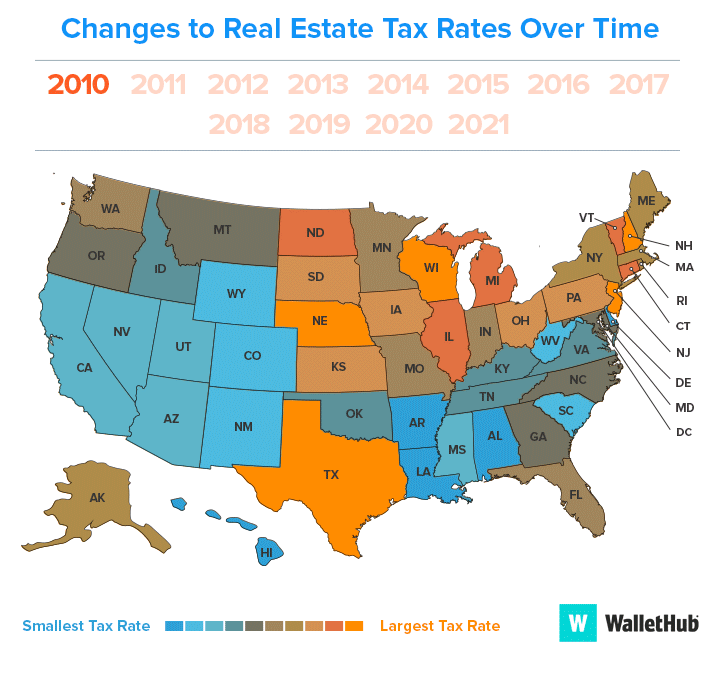Upstate NY Has Some of the Highest Property Tax Rates in the Nation

What Contributes to Upstate New York’s High Property Taxes and What Can You Do?
- Taxes are imposed by town and county governments and school districts. Those budgets have tended to increase despite declines in population and school enrollments in many areas over past few years.
- Assessments may be higher than they should be due to a complex and flawed assessment process. If you feel your assessment is not accurate, you can challenge it at the annual grievance day or by contacting your assessor for an informal review. See 5 Ways to Challenge Your Assessment
- Citizens must pay attention to school budgets, question budget increases, and vote!
- Another way to reduce your assessment and your tax bill is to apply for eligible exemptions.
Property Taxes By State
2023 Data | Source: WiseVoter

SALT Deduction Cap Hits Property Owners in the Highest Tax States the Most
In the Tax Cuts and Jobs Act of 2017, the SALT (state and local taxes) deduction was capped at $10,000. That is now the maximum deduction allowed for those who itemize deductions when filing Federal income tax returns. Prior to the cap, taxpayers could deduct all eligible state and local taxes they paid during the year from their federal tax return, including property taxes plus either state income or sales taxes. The cap impacted taxpayers in states including New York, where property and school taxes are higher, pay higher federal tax bills.
According to the National Association of Counties: "The Tax Relief for Middle Class Families Act of 2023 (H.R. 680), introduced by Reps. Mikie Sherill (D-N.J.), Mike Lawler (R-N.Y.), Mike Levin (D-Calif.) and Eleanor Holmes Norton (D-D.C.), would increase the current cap on the SALT deduction from $10,000 (and $5,000 in the case of a married individual filing a separate return) to $100,000 (and $200,000 in the case of a joint return). If enacted, this change would become effective beginning in the 2023 tax year. Rep. Sherrill is a Vice-Chair of the Bipartisan SALT Caucus and Reps. Lawler and Holmes-Norton are members of the caucus as well. Reps. Sherrill and Lawler also introduced separate legislation that would increase the SALT cap from $10,000 to $20,000 for married couples filing a joint return (H.R. 339) and Rep. Sherrill sponsored similar pieces of legislation in the 117th Congress.
To date, no action has been taken to raise the cap. If Congress does not make this permanent, the SALT deduction cap of $10,000 per household will expire as scheduled after 2025.
States With the Highest Property Taxes

Using data from the Tax Foundation, GOBankingRates ranked the states with the highest property taxes in America, including the percentage rate, the average dollar amount paid and the average home value. The top 15 are ranked in ascending order from least expensive to most.
New York ranked 13
- New York average effective property tax: 1.38%
- 2022 average home value: $370,445
- Average annual property tax paid: $5,112
New York ties with Michigan for states with highest property taxes, though New York’s are $1,966 higher, significantly higher. The average home value is also quite a bit higher in New York than the other states, but its residents still pay a relatively low property tax rate.
For context, the national average effective property tax is 1.04%, the U.S. average home value is $349,015 and the average annual property tax bill is $3,630.
Where People Pay the Most in Property Taxes
According to the non-profit Tax Foundation, New York ranks 4th in the nation for state and local property tax collections per capita and 14th for property taxes paid as a percentage of owner-occupied housing value

Wallet Hub's latest report in March 2022 shows what states are bearing the biggest property tax load. NYS has an effective real estate tax rate of 1.72%, which puts New York in 43rd place in the nation for the lowest property taxes.
Wallet Hub Also Looks at How Property Taxes Have Changed Over Time
Americans Moved to Low-Tax States in 2023
According to the non-profit Tax Foundation - The U.S. population grew 0.49 percent between July 2022 and July 2023, an increase from the previous year’s 0.37 percent. While international migration contributed to population growth at the national level, interstate migration was the key driver of net population changes at the state level. The U.S. Census Bureau’s most recent interstate migration estimates show that New York lost the greatest share of its population (1.1 percent) to other states between July 2022 and July 2023. This population shift paints a clear picture: Americans are leaving high-tax, high-cost-of-living states in favor of lower-tax, lower-cost alternatives. See full report

NYS Ranks #2 in Local Tax Collections - What It May Mean in 2024
According to the Tax Foundation, "The rate of revenue growth witnessed in FY 2021 was never going to be sustainable, but most states remain substantially better off than they were pre-pandemic, even after adopting tax relief, with every expectation that the new baseline is far higher than it was before. Revenues are high enough, in some states, that the tax-cutting trends of 2021-2023 are likely to continue into 2024.

Updated Jan 22, 2024

